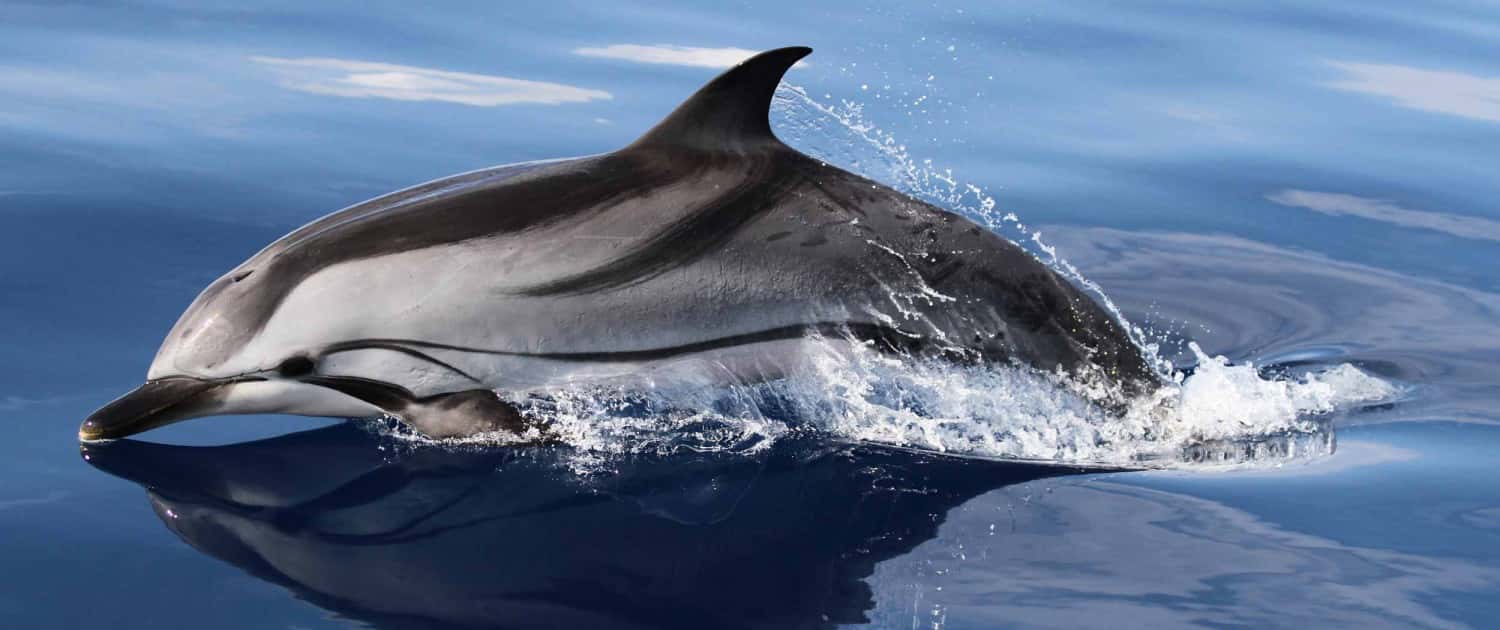Striped dolphins are the most abundant pelagic cetaceans in the Mediterranean, and the most frequently observed cetacean in the Pelagos Sanctuary (Forcada et al. 1995, 2009, Panigada et al. 2011).
Tethys’ research targeting striped dolphins included:
- a study providing a basis for the evaluation of potential disturbance of striped dolphins by boats in the Ligurian Sea Sanctuary, an area with intense maritime traffic, carried out in 2000-2001. Behavioural variables were analysed by means of multivariate statistical methods, leading to the definition of categories that can be used for further quantifying anthropogenic impact on striped dolphins and for figuring out appropriate codes of conduct for whale-watching boats (Jahoda et al. 2005);
- an investigation of social kin associations and genetic structure of striped dolphin populations in the Mediterranean were investigated in 2000-2006, analysing samples from the Adriatic, Scotland and Spain for population-level comparisons. Structure was found within the Mediterranean, including small but significant differences between Adriatic and Tyrrhenian, and between putative “inshore” and “offshore” populations in the Tyrrhenian Sea. Comparisons of relatedness for both sexes showed a significant difference between males and females, with females more likely to associate with adult kin and a greater male dispersal. Together these data emphasize the importance of the social cohesion of kin in small groups to the structuring of striped dolphin populations in this environment (Gaspari et al. 2007);
- a study of the vocal repertoire of striped dolphins in the Ligurian Sea through audio recordings in 2007-2008, using multiple variates (acoustic whistle shapes, group size, age/sex composition and physiographical parameters) to investigate population structure of striped dolphins in the Ligurian Sea and confirm genetically derived differentiation between inshore and offshore individuals (Gitter at al. 2009);
- a long-term study of an enclosed and likely isolated population of striped dolphins in the Gulf of Corinth (2009-2012, later continued by the “Dolphin Biology and Conservation” NGO), based in Galaxidi, Greece. The gulf is a semi-closed basin of extraordinary interest, where about 800 striped dolphins (typically pelagic cetaceans) are found close to shore, often in association (and likely breeding) with a small number of resident short-beaked common dolphins, Delphinus delphis (Bearzi et al. 2011);
- dedicated aerial surveys conducted in 2013-2014 in the central and southern Tyrrhenian Sea, to assess possible changes in distribution and abundance of striped dolphins following a dramatic increase of stranding due to an unknown pathological event. Estimates showed a substantial decline (30-40%) in the dolphins’ abundance of striped dolphins, compared to identical surveys in 2010-2011 (Panigada et al. 2015).
Literature
Jahoda M., Azzellino A., Airoldi S., Francia C. 2005. Definition of behavioural categories in striped dolphins (Stenella coeruleoalba) in the Ligurian Sea Sanctuary in the presence of boats. European Research on Cetaceans, 19
Forcada, J., Notarbartolo Di Sciara, G., Fabbri, F., 1995. Abundance of fin whales and striped dolphins summering in the Corso-Ligurian Basin. Mammalia 59, 127–140. doi:10.1515/mamm.1995.59.1.127
Forcada, J., Notarbartolo Di Sciara, G., Fabbri, F., 2009. Abundance of fin whales and striped dolphins summering in the Corso-Ligurian Basin. Mammalia 59, 127–140. doi:10.1515/mamm.1995.59.1.127
Panigada, S., Lauriano, G., Burt, L., Pierantonio, N., Donovan, G., 2011. Monitoring Winter and Summer Abundance of Cetaceans in the Pelagos Sanctuary (Northwestern Mediterranean Sea) Through Aerial Surveys. PLoS ONE 6, e22878. doi:10.1371/journal.pone.0022878
Gaspari, S., Azzellino A., Airoldi, S., Hoelzel, A.R. 2007. Social kin associations and genetic structuring of striped dolphin populations (Stenella coeruleoalba) in the Mediterranean Sea. Molecular Ecology 16, 2922-2933.
Gitter S.J., Panigada S., Airoldi S., Thomas J. 2009. Whistle repertoire and geographic variation of striped dolphins (Stenella coeruleoalba) in the Pelagos Sanctuary (Mediterranean Sea). 18th Biennial Conference on the Biology of Marine Mammals, Quebec City, Canada, 12-16 October 2009.
Bearzi G., Bonizzoni S., Agazzi S., Gonzalvo J., Currey R.J.C. 2011. Striped dolphins and short-beaked common dolphins in the Gulf of Corinth, Greece: abundance estimates from dorsal fin photographs. Marine Mammal Science 27(3):E165–E184.
Panigada S., Pierantonio N., Donovan G.P., Gonzalvo J., Zanardelli M., David L., Cañadas A., Lauriano G. 2015. Are striped dolphins in the Central Mediterranean Sea declining? The importance of systematic monitoring to assess trends and develop effective conservation strategies. 29th Annual Conference of the European Cetacean Society, Malta, 23–25 March 2015.


